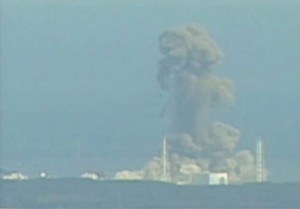The men and women who design, build, and work at nuclear power plants are bright, dedicated people who work hard so that when we flip a switch the power flows, so we can use our computers, watch our tvs, refrigerate our food, microwave our dinners and our popcorn, heat, cool, and vacuum our homes, and jam on our electric pianos and electric guitars when we want to. The drive, dedication and service of the engineers at Fukushima is heroic.
Under normal conditions, nuclear power emits less pollutants than coal, and the waste from nuclear power is regulated. The wastes from coal are not.
Yet, radioactive materials are an intrinsic property of nuclear power; consequently meltdown and disaster are inherent dangers. The disasters at Fukushima Dai-ichi, Fukushima Diaini, and Onagawa, while not predictable, were not unexpected. We’ve seen Chernobyl in ’86, Three Mile Island in ’79. We’ve had fires at Brown’s Ferry. We have had, and continue to have leaks of radioactive material at Oyster Creek, Indian Point, Vermont Yankee, the Hanford Nuclear Reservation and every other nuclear facility in the United States, Japan, France, and I am sure, the rest of the world.
And we learned what? To ‘harden’ the plants? To spare no expense in a fanatical devotion to safety and maintenance?
No. To cut corners and to defer maintenance. To extend to 60 years the life of plants designed to last 40 years.
I drive an 11 year old car with 158,000 miles under it’s engine. I’m on my third set of tires. I change the oil every 3 months or 3,000 miles, or 4 months or 4,000 miles when I’m busy and stressed. When I hold off on an oil change to 4 months or 4,000 miles, I allow negligible damage to the engine and decrease performance. if I tried to stretch it to 2 years or 30,000 miles between oil changes I would destroy the engine. I can probably get another 10 years and another 125,000 miles out of the car if I baby it. But I don’t know if I could drive it 60 years and 1.2 million miles. Yet this is how we attempt to manage our nuclear power plants.
The U.S. says people should not go within 50 miles of Fukushima. That’s a circular area of approximately 7,850 square miles. Indian Point, on the east bank of the Hudson River, is located 35 miles from Manhattan. It was built to withstand a 6.0 earthquake and was built along the Ramapo earthquake fault. Japanese authorities now tell us their killer quake was 9.0. The U. S. Geological Survey reported 154 aftershocks of 5.0 or greater and 27 aftershocks measuring 6.0 or greater in Japan. Could Indian Point withstand an earthquake that measures 9.0 with 154 aftershocks of 5.0 or greater, 27 measuring 6.0 or greater – in a week? Japan moved 8 feet to the east. If Indian Point moves 8 feet to the west it will be swimming.
We should, with all deliberate speed, decommission every nuclear reactor and replace them with wind, solar, geothermal, other renewable, sustainable technologies, and the “negawatt” virtual-reactors of efficiency.
Like Chernobyl # 4, We should entomb Fukushima Dai-ichi in a sarcophagus the size of the Pyramids. And rather than Yucca Mountain, we should very politely ask the Japanese to transform Fukushima Dai-ichi into a nuclear waste repository for the future.
The question is not:
“Can we meet our needs with renewable, sustainable energy systems?”
but rather it is
“How can we meet our needs with renewable, sustainable energy systems?”
Latestin a series on the economics, ecological economics, finance, logistics, and systems dynamics of nuclear power in the light of the ongoing catastrophe at Fukushima.
- Earthquake, Tsunami and Energy Policy, March 11-13, 2011. Here.
- After Fukushima, Wall Street Bearish on Nuclear Power. March 14, 2011. Here.
- Fukushima: Worse than Chernobyl? Here.
- Fukushima: GE Mark 1: Unsustainable by Design. Here
- Is Fukushima Dai-icha worse than Chernobyl? Here.
- Nuclear Power: What Future? Here.
